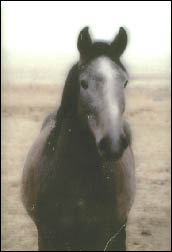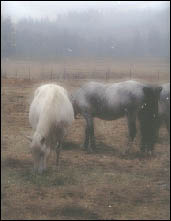

Most everyone has seen performances of the Spanish Riding School either on TV or during their world tours. Those amazing gray, strong horses seem to obey their riders' commands with ease and grace as if in a classical painting from the Baroque era in Europe. But very few people know that the Lippizan breed is alive and well in the United States.
Tucked in the north end of Goldendale, Wash. is the largest breeding farm of Lippizan horses on the west coast. White Vale Lippizan Farm can only be topped in numbers by breeders in Vermont and Missouri but few can top the quality. June and Leonard Boardman have been breeding these noble horses since 1985 when they bought their first Lippizans.
Previously, the Boardmans had been breeding Appaloosas and Arabians but had been caught by the mystique of Lippizans during a trip to Europe in 1970. Impressed by the animal's quiet nature and sturdy physique, they felt these horses fit the ideal of a practical horse. Founded in 1580 by an Archduke of the Hapsburg Empire (formerly Austria), the Archduke bought six stallions from Spain and founded a stud farm in Slovenia. The breed's foundation mares were local Karst horses which were used by the Romans for chariot racing.
After developing an interest and studying the history of the breed, the Boardmans finally bought a yearling, a two-year old and a mare in foal at a sale in Hermiston, Ore. The horses, from original Spanish Riding School stock, had been sold to pay off provincial taxes in BC after their owner had died. Next to starved to death, the Boardman's took them home and began what would become a breeding operation currently totaling more than 40 horses.
Because the breed was originally intended for Hapsburg nobility, and often given as gifts, there were never very many Lippizans bred. There are currently between 700 and 800 horses in the US and only 3,500 in the world. Not until the Hapsburg nobles were overthrown during World War II did Lippizans become available to the common man.
These medium sized horses, averaging between 15 and 15'2 hands, are very carefully monitored for qualities necessary in riding and driving horses. More important than color and looks are trainability, known as temperament in the European Union, and intelligence. Noble heads, and occasionally roman noses, are common in the breed because the face type was popular during the Baroque period. Known for being straight movers with occasional high-kneed trots, they are built more for strength and ability rather than speed. Their arched necks set high into the withers and the Lippizans are known for their good, sturdy bones and thick hoof walls.
The hooves are large for their size and are usually kept sectiony as an upright foot keeps them healthy. Spanish Riding School horses are only shod when on the road and the Boardmans' horses are only shod when they go to shows. Traditionally, the Lippizans were open grazed in large herds in the Alps, which is why these strong hooves were desired. The Boardmans always ride their horses barefoot in the mountains. According to June, they are most often used for dressage, pleasure and combined driving, but "a lot of people don't know you can come here, buy one, throw a western saddle on them and go riding in the mountains." June's ferrier uses her Lippizans for working with cattle.
They are slow maturing horses, usually mature by eight years old but often will have a growth spurt around age six. They usually live until their 30s and aren't really worked with until they are three or four.
Lippizans are trained before they are bred. In Europe, stallions are most often trained to Grand Prix level dressage while the mares are trained under saddle and driving. June believes this practice needs to be kept up in the U.S. "We're doing more than breeding horses here," said June. "We're saving them from extinction." Because there are so few horses worldwide, it is important to "do the right thing." June has turned down breedings because the pedigrees were to close. She won't breed unless there is at least three generations between stallion and mare and she hopes to eventually achieve five generation spreads.
The traditional style of naming is still used at White Vale. Males have two names with the first name being the stallion line, of which there are only six, and the second is the mother's name. The six stallion lines are Maestoso, Favory, Conversano, Neapolitano, Siglavy, and Pluto. The females always have names ending in "a". The Boardmans name the females with the first letter of the dam's name. At their farm, they have the O, S, A and C families.
Previously, White Vale's strong suit was their dam lines but last year, they imported a stallion recommended by Dr. Olaila, the Spanish Riding School's director. They imported another stallion this spring of the Favory line, which is the rarest line in the US.
The Boardmans have developed a good relationship with Dr. Olaila over the years. Since 1994, Dr. Olaila has come to their farm during the summers for evaluations and puts on a two-day seminar on judging and basic Lippizan 101. He is brought over because there are no Lippizan experts in the US due to the lack of breed tradition in this country.

The evaluations are sponsored by the American Lippizan Breeders Association, partly founded by the Boardmans. The ALBA is putting together a stud book, which should be done January 1, to be forwarded to Austria and included in the EU stud book. New rules will be released about the same time from the EU regarding performance standards. The minimum standards, which is guessed to be 2nd level dressage and L level driving, will be requirements for breeding horses and individual national associations will determine higher standards.
Lippizans are evaluated on a 100-point scale. The scale includes points for confirmation, movement, suppleness and willingness as well as typeyness and maleness/femaleness. According to June, a good score is 80 or above.
White Vale is expecting between six and eight foals for next spring. They usually average eight foals per spring, with 10 being the most. Most sell before three years of age and prices start at $5,000. They use their own stallions and one outside stallion to insure good breeding. The Boardmans' goals for their farm is to bring the word of Lippizans to the public. "We want the best breed quality, to preserve the traditional qualities and let other people know about them," said June.